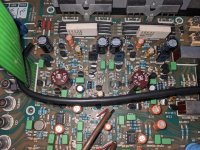It's not necessarily a bad cap. And there's hope that the output transistors haven't failed since you sometimes hear clear loud music.
First step is to confirm that protection has activated. If the amp were operating correctly there would be about 1.2V across C39 (lower left corner). If in protect mode, this voltage will be reduced to a few mV. Would you confirm?
First step is to confirm that protection has activated. If the amp were operating correctly there would be about 1.2V across C39 (lower left corner). If in protect mode, this voltage will be reduced to a few mV. Would you confirm?
Just confirming this volts across C39?
Next step is to disable protection circuit so that amp is forced to operate. There is some risk in doing this, but if you consistently hear clear loud audio when you cycle power, this is encouraging.
Don't put your speakers at risk. Test without speakers first. Put a resistor in series with them to limit applied power when you reconnect. Install a temporary short across R59; this will enable current source Q11 despite protection fault. Apply power but be quick to power down if there's smoke. If there's no drama, report DC on speaker terminals.
Next step is to disable protection circuit so that amp is forced to operate. There is some risk in doing this, but if you consistently hear clear loud audio when you cycle power, this is encouraging.
Don't put your speakers at risk. Test without speakers first. Put a resistor in series with them to limit applied power when you reconnect. Install a temporary short across R59; this will enable current source Q11 despite protection fault. Apply power but be quick to power down if there's smoke. If there's no drama, report DC on speaker terminals.
OK I have an update from the seller in an email sent a little while back. He mentioned using it with a PSX but it kept blowing fuses. When I purchased the amplifier I notice the fuses were inside but blown.
I gather from his email he was using the amplifier with the PSX and did not remove the fuses!!
I gather from his email he was using the amplifier with the PSX and did not remove the fuses!!
Sounds tricky for me. I rather get it back to 100% with whatever the fault maybeJust confirming this volts across C39?
Next step is to disable protection circuit so that amp is forced to operate. There is some risk in doing this, but if you consistently hear clear loud audio when you cycle power, this is encouraging.
Don't put your speakers at risk. Test without speakers first. Put a resistor in series with them to limit applied power when you reconnect. Install a temporary short across R59; this will enable current source Q11 despite protection fault. Apply power but be quick to power down if there's smoke. If there's no drama, report DC on speaker terminals.
This is how I would locate the problem. But please clarify: you now see 1.3V across C39? Where were you measuring in post 24?
Correction: Where measuring in post 22?
Correction: Where measuring in post 22?
Not necessarily. There might be a failed transistor or other component in the fault detection circuit.
I understand your reluctance to disable fault protection. Please confirm return of audio after power cycling. How long is delay before protect is retriggered?
I'll probably refer to components in the working channel for convenience, but please make the translation to the problem channel.
You can confirm resistance of R107A, R107B in circuit with power off. Probably OK. Other suspect parts would be Q37, Q35, R101, R99.
You can confirm resistance of R107A, R107B in circuit with power off. Probably OK. Other suspect parts would be Q37, Q35, R101, R99.
Another safe test you can perform is to install a short across C51. This disables the class AB compensation; you'll get crossover distortion but if there's no longer fault protection, the bias comp fall under suspicion.
I just compared both channels and they are identical. I also checked driver ransistors, all good!I'll probably refer to components in the working channel for convenience, but please make the translation to the problem channel.
You can confirm resistance of R107A, R107B in circuit with power off. Probably OK. Other suspect parts would be Q37, Q35, R101, R99.
Q37, Q35 is working channel and Q38, Q36 faulty channel. All measure same with diode tester
C52 is faulty channel. You say short that? If I do what do I expect? sound on both channels?Another safe test you can perform is to install a short across C51. This disables the class AB compensation; you'll get crossover distortion but if there's no longer fault protection, the bias comp fall under suspicion.
- Home
- Amplifiers
- Solid State
- Cyrus Two only works when switched off!
